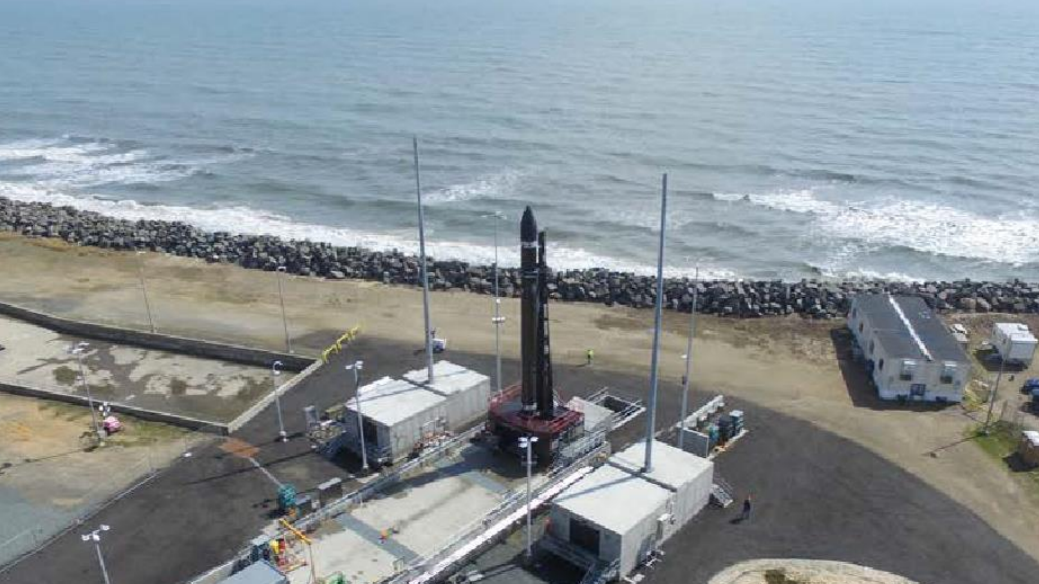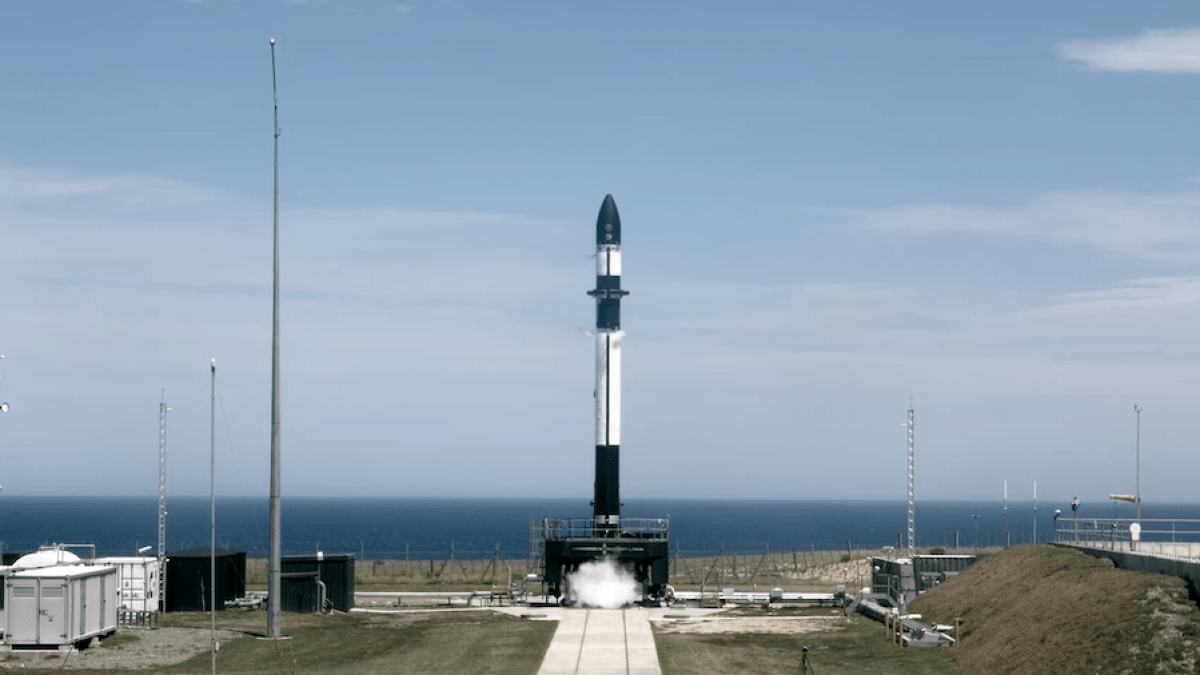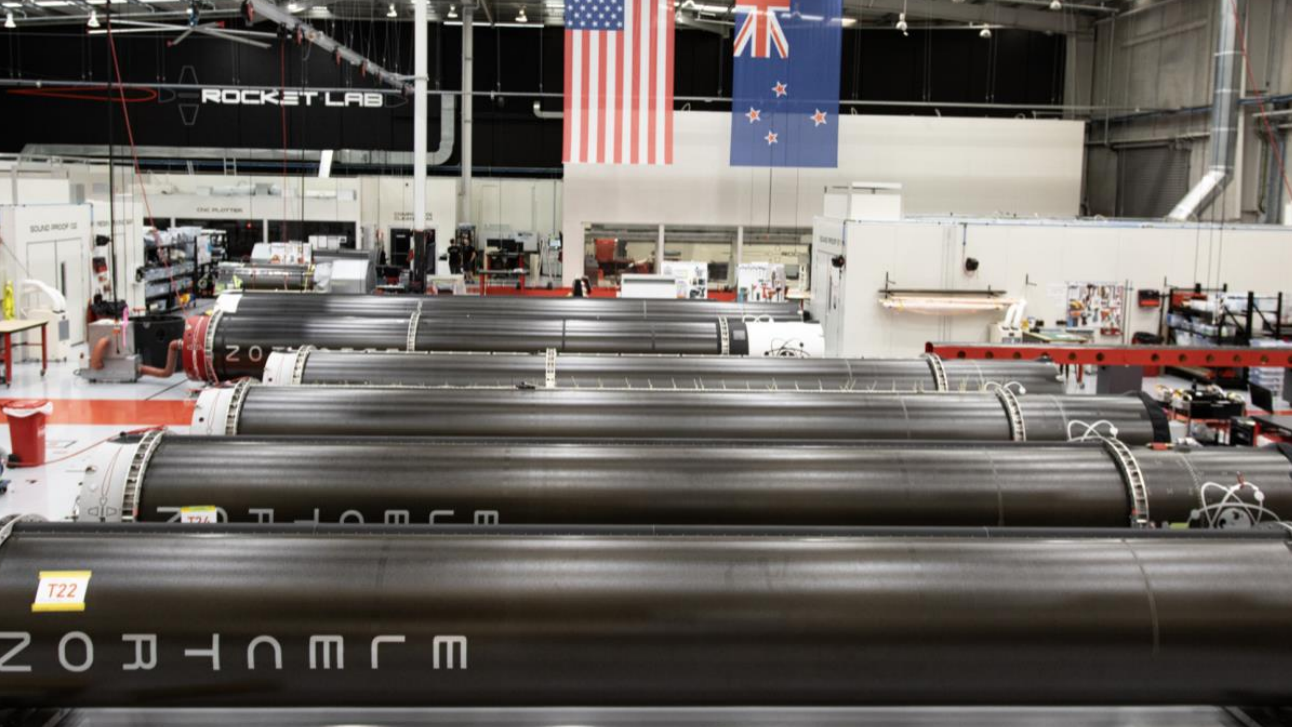
Construction of Launch Complex 2 at Wallops Island began in February 2019 and was completed just 10 months later. Infrastructure includes a 66ton launch pad and 7.6ton strongback for the Electron rocket launch vehicle. (Rocket Lab)
Correction 12/14/2022 at 3:57 pm ET: This story originally referred to Rocket Lab as a New Zealand-based company. While the firm was founded in New Zealand, its corporate headquarters is now in the United States. This story has been updated.
AUCKLAND — Startup space and satellite company Rocket Lab is on the precipice of a major milestone: the company’s first US launch of its Electron rocket.
A leader in the small launch market, Rocket Lab opened its US facility Launch Complex 2 (LC2) at Virginia Space’s Mid-Atlantic Regional Spaceport within NASA’s Wallops Flight Facility Wallops Island, Virginia, in 2020. Now, the company is prepping for a launch sometime in the Dec. 9-20 range. It follows the Dec. 1 announcement that the company has launched a new US subsidiary, Rocket Lab National Security, to specifically focus on defense and intelligence business from the US and its allies.
As the US military harnesses the private sector to advance its surge into space, Rocket Lab — its only overseas-based partner — is becoming an increasingly important part of future US satellite programs, particularly in the small satellite domain. The company has already launched four systems for the US National Reconnaissance Office (NRO), including two in 2020 and two this summer from its Launch Complex 1 (LC1) site on the Mahia Peninsula on the east coast of New Zealand’s North Island. The latter two are key, as they fit into what the Americans call “operationally responsive” capabilities.
In July, Rocket Lab lofted NROL-162, the first of a pair of satellites with the Australian Department of Defence. Three weeks later, it successfully launched NROL-199 into orbit.
The pair of launches were designed to prove the capability for the rapid launch of small satellites in succession using a commercial provider. Rocket Lab used its Electron rocket to launch the NRO’s payloads under the latter’s Rapid Acquisition of a Small Rocket (RASR) contract.
Although the second launch was delayed to 15 working days after the first because the NRO needed extra time for its payloads, Peter Beck, the CEO of the company, said that Rocket Lab was set to launch 10 days after the first system went up. That’s “a big capability that the defense industry is looking for,” he said, which “demonstrated that this is a capability that exists now with Electron and that Rocket Lab is the only small launcher that can do the rapid turnaround that they are looking for.”
The first launch from American soil would seem to represent another major tie-up between Rocket Lab and the US national security apparatus. The development of LC2 was partly funded and designed by the US, and Beck said the layout of the entire LC2 facility, including the integration and launch areas, is to offer a service for its US customers that is “optimised for responsive access to space.” It can support 12 missions per year to supplement the 120 that are capable annually from LC1. He added that the LC2 facility “can process two Electrons simultaneously and within 24 hours launch the rockets,” at least on paper.
Beck, who spoke to Breaking Defense in September, indicated the LC2 first launch could have happened sooner if NASA had been ready. “We have just been waiting on NASA’s Autonomous Flight Termination System (ATFS) certification of their own software, which is intensely frustrating,” he said.
While waiting on the space agency, Rocket Lab completed a final launch rehearsal in November in anticipation of this month’s launch. This will be the first time an AFTS will be flown from the Wallops Island spaceport, representing a valuable new capability for the US.
Rocket Lab will complete three Electron launches from LC2 delivering 15 RF monitoring low Earth orbit (LEO) satellites for HawkEye 360 through 2022-2024 to expand the constellation.
Rocket Lab’s Electron rocket is an 18m-tall, 1.2m-wide expendable launch vehicle that can deliver 300kg payloads into LEO. The value of the Electron rocket is that each can be built in 18-20 days. It cuts down the amount of time needed to prepare and launch a payload into space and accelerate the path to orbit and establish a rapid call-up launch-on-demand solution.
Beck isn’t shy about hyping the Electron rocket as a disruptive technology. “SpaceX came into the large launch market and a $300 million launch got turned into a $100 million launch. Rocket Lab came into the small launch market where you had Pegasus and Minotaurs [built by Northrop Grumman] costing about $50 million per launch. We took that down to $7.5 million. If you are a government or commercial customer used to paying $50 million but you can get a better service, more responsive, faster and more accurate for $7.5 million, that is a pretty big game changer,” he said.

Rocket Lab Electron booster on the pad in New Zealand. (Rocket Lab)
He added that Rocket Lab’s ability to reduce costs comes down to the fact it is not a “big prime” like some of its competitors, when there are additional factors to consider in the supply chain. Being vertically integrated “gives you so much control over the cost of the supply chain and schedule and delivery… you see raw powder and raw composite comes in one door and a complete rocket comes out the other.”
Next on Beck’s to-do list is turning Electron into a reusable rocket by recovering the first stage vehicle after it returns to earth without it falling into the sea first, which could damage the systems. The design involves the rocket deploying a parachute once in the Earth’s atmosphere, slowing its descent so that it can be hooked by a helicopter midair. The first stage represents 65% of the total cost of the Electron rocket, so recovering this will allow for significant cost reductions. When Electron is recoverable the first stage will be used for 50% of future launches; however, not all trajectories lend themselves to reusability and about 10-15% of the performance of the vehicle is lost per launch.
Picking a rocket off mid-air with a rotorcraft looks difficult on paper, and has proven to be challenging in the real world. So far, two attempts have been made. The first was caught in flight, during an attempt in early 2022, but had to be released due to the motion of the rocket under the helicopter. The second attempt on Nov. 4 was aborted because of a temporary telemetry failure during re-entry.
Although both efforts were unsuccessful, Beck said that the launches “demonstrated 90% of what we needed to do in the reusability program.”
The company recently completed a successful re-firing of an Electron Rutherford engine, which powers the rocket’s first stage, from one of the recovered launches. The engine is performing to the same standard as a new-build Rutherford and represents a significant milestone in the reusability program.
New Launch Locations, Rocket Designs Coming
Meanwhile the company is about to enter the large launch market and is building a new Launch Complex 3 (LC3) adjacent to the LC2 site at Wallops. LC3 includes a production factory for the construction of a new larger reusable rocket called Neutron. It is a 42.8m-tall (140.4ft), 7m-wide rocket with a 480,000kg) launch weight. It can carry an 8,000kg payload into LEO orbit and return to the launch pad. Maximum payload to LEO is 15,000kg if an expendable rocket is used, or a 1,500kg payload to a deep space locale such as Mars or Venus. A first launch of Neutron from LC3 is expected in 2024.
Rocket Lab has harnessed the knowledge developed from using Electron to advance the Neutron concept. “Neutron’s geometry and concept of operations is wildly different to a traditional expendable launch vehicle and that is because we learned about re-entry, guidance and other things from Electron that we have put directly into Neutron,” Beck said.
With Neutron, as much of the rocket is being retained as possible for reuse, including the fairings. A key difference between Neutron and Electron is that on re-entry Neutron will guide itself back to the launch site using canards to control maneuvers and rocket fires to slow the descent to return to the launch pad.
“We are the dominating player in small launch — it is niche and we own that market — but a lot of our Electron customers have further plans or are developing bigger constellations. So the development of Neutron was really customer pull as they want a bigger rocket so they can launch all of their large constellations on it,” Beck said.
In September 2021, US Space Force awarded a $24.35 million Upper Stage Resiliency Enhancements Other Transaction Authority (OTA) contract to Rocket Lab targeted for the development of a unique new design of an upper stage for Neutron. “How we were building a high-performance upper stage was of most interest to USSF,” Beck said. (Similar contracts were awarded to Blue Origin for its New Glenn rocket, Boeing-Lockheed Martin for the Vulcan Centaur rocket and SpaceX for Starship.)
A spokesperson from the USSF told Breaking Defense that it is “focused on growing space capabilities to deter and counter increasing adversary threats.” The USSF spokesperson added that “continued partnerships with companies like Rocket Lab and their Neutron development are very important to the USSF because they aim to ensure space access by expanding the commercial launch enterprise.”
Beck explained that developing an upper stage is a difficult engineering space because the vehicle has conflicting constraints: it is disposable and therefore needs to be cheap, but also needs to be the highest performance part of the rocket. It has a 1:1 ratio payload, meaning every 1kg of upper stage weight equals 1kg loss of payload, which is much more constraining compared to just 8:1 on the first stage that boosts the rocket out of the Earth’s atmosphere. Composite materials are used to achieve the performance characteristics needed..
“A key aspect of the USSF contract is it on-ramps Neutron into the National Security Space Launch (NSSL) program, which is the top level of national security payloads that are awarded. This shows they have the confidence that this vehicle will be suited for those missions in the future, which are now only going to SpaceX and United Launch Alliance (ULA),” Beck said.
The USSF spokesperson said that it issued the Upper Stage Resiliency Enhancements OTAs “to stimulate and leverage the growing commercial launch market to increase acquisition flexibility for NSSL-class missions and improve space access capabilities,” adding that, “The USSF anticipates that the efforts will reduce costs by enabling the procurement of lower-energy low voltage configuration and will also improve mass-to-orbit capability.”
This will put Rocket Lab into direct competition with United Launch Alliance (ULA) and SpaceX, the latter of whom has a head start. On Nov. 1, USSF announced that it had launched its first NSSL mission using a SpaceX Falcon Heavy rocket to launch a Long Duration Propulsive EELV (Evolved Expendable Launch Vehicle) Secondary Payload Adapter (ESPA), or LDPE-2, and Shepherd Demonstration mission. USSF stated that the LDPE-2 space vehicle will “deliver six payloads that advance communications, space weather sensing and other technologies into near-geosynchronous orbits.”

Electron rockets in various stages of production at the Rocket Lab facility in Auckland, New Zealand. Opened in October 2018 the 7,500sq/m (80,700sq/ft) facility is specially designed for rapid mass production of Electron delivery vehicles and for integration and testing prior to delivery to Launch Complex 1 on the Mahia Peninsula. The Auckland facility also includes the Mission Control terminal for launches from both LC1 and LC2 on Wallops Island in Virginia, US. (Rocket Lab)
Progress is ongoing with the Neutron project. Construction is underway on the Neutron Production Complex, the launch site is secured and vehicle hardware is in testing. The second stage design has been completed, and the concept design review and system requirement review completed. The new 11.5m-tall Archimedes engine that will power Neutron remains on track for engine pre-burner testing into the end of 2023 at NASA Stennis Space Centre’s A-3 Test Complex where the new Archimedes Test Complex was opened on Nov. 4.
The USSF spokesperson said that after the OTAs conclude in fiscal 2023 it will “continue to monitor industry and the innovations they bring to the nation. These public-private partnerships push the technological boundaries and harness industry innovation to help the USSF meet future space capability needs and potentially provide new space access capabilities to the warfighter.”
On Sept. 6 2022 Rocket Lab also signed a Cooperative Research and Development Agreement (CRADA) with US Transportation Command (USTRANSCOM) “to explore the possibility of using Neutron for point-to-point cargo delivery around the world.” This is part of the US Air Force’s Rocket Cargo Vanguard program that is designed to advance emerging systems and concepts through prototyping and experimentation to deliver new capabilities.
Launch capabilities are not the only part of Beck’s plan for Rocket Lab. He said the launch market is about $10 billion per year, while the spacecraft market for satellites and satellite delivery vehicles is about $25 billion — but that providing hardware and software to support space assets are a $320 billion market. “Rocket Lab’s view is that we are end-to-end. Launch is very important it is a huge enabler and gives you a competitive advantage, we are not stopping there,” he said.
Through Rocket Lab’s recent acquisitions it is becoming a more complete supplier of space systems moving into payloads and essential subsystems. The 2022 purchase of Solaero means that Rocket Lab is now only one of three manufacturers of space-grade solar panels in the world. This gives it a guaranteed supply of solar panels and a dominant position in that market. The acquisition of Sinclair Interplanetary (in April 2020) provides satellite hardware; Advanced Solutions (in October 2021) for space guidance, navigation and control software; and Planetary Systems Corp (in December 2021) for satellite separation systems.
The activation of LC2 and the construction of LC3 will likely shift Rocket Lab towards its American operations but its New Zealand site remains essential and its use by the US government has had further international ramifications.
Launching US government satellites from New Zealand required a bilateral treaty and technology safeguard agreement (TSA) signed between Washington and Wellington before Rocket Lab and the NRO could proceed. This was a landmark arrangement as the NROL satellites were the first US defence satellites to be launched outside of the US. The TSA is now being used by Australia and the UK as the basis for their own relationship for space between their governments and the US.






















